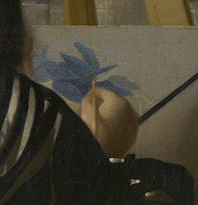Details: Vermeer's Painting Methods & Techniques
YOUNG WOMAN WITH A WATER PITCHER
c. 1664-1665
oil on canvas
18 x 16 in. (45.7 x 40.6 cm)
The Metropolitan Museum of Art, New York
lapis lazuli
Vermeer, as many painters of his time, employed a very limited palette consisting of approximately ten to twelve pigments. The only substantial difference was his use of genuine ultramarine (pure lapis lazuli) rather than the much cheaper azurite. Genuine ultramarine is made of the powder of the crushed semi-precious stone lapis lazuli which, after being thoroughly purified by repeated washings, is bonded to a drying oil (walnut, linseed or poppy oil) through hand mulling. The exact proportions between pigment (powdered lapis lazuli) and vehicle (natural drying oil) and correct amount of hand mulling necessary to produce the highest quality paint can be only acquired by experience. Even when the process is mastered the resulting paint has a very fastidious stringy quality which makes it difficult to brush out evenly. However, mixed with white this defect is less noticeable. The final product is a very deep transparent blue. Set aside other pigments on the artist's palette, it is one of the darkest, only black is darker. Mixed with lead white, it maintains its radiant purity and brilliance even in the palest shades. The superior cost, complicated preparation and poor brushing qualities of genuine ultramarine are offset by the exceptional brilliance and purity of the final product. Genuine ultramarine made of lapis lazuli is no longer produced and has been replaced by synthetically produced ultramarine blue.
A fine example of genuine ultramarine can be seen in the satin gown of Woman in Blue Reading a Letter, although it is now far less brilliant today due to aging of the varnish. The gem-like depth of the wrap in The Milkmaid is another. In this case, the excellent state of conservation of the painting allows us to appreciate in full the chromatic brilliance of pure lapis lazuli. Although genuine ultramarine can be found in almost every painting by Vermeer, it is truly surprising to what extent Vermeer actually employed the pigment. Not only is it found in blue colored objects themselves but upon close inspection traces can be found in the shaded portions of white drapery, black marble tiles, green foliage, white washed walls and even in the shadows of the brilliant orange gown in The Glass of Wine
Vermeer's copious use of genuine ultramarine seems to have reached an almost obsessive degree unless we understand just how perceptive was the artist's eye. Vermeer realized early in his career that the admixture of genuine ultramarine with tones of gray, usually composed of lead white, bone black and raw umber in varying proportions, lends them a characteristic luminosity produced by intense daylight which cannot be produced otherwise. This technique is to found only in Vermeer's paintings. Mixtures of blue in the shadows was to be employed many years later by the French impressionists to suggest the effect of full daylight . Such an intuition on Vermeer's part denotes the powerful inventiveness that is one of the principal characteristics of Vermeer's painting techniques.
An excellent example of Vermeer's extensive use of genuine ultramarine can be found in Young Woman with a Water Pitcher. Obviously, it was used to paint the folded blue drapery on the table, in a more or less conventional way. It was also used in the window to render the incoming daylight which passes through the glass pains. Vermeer applied delicate opaque and semi-transparent layers of genuine ultramarine mixed with white lead in varying proportions over the warm tone of the canvas preparation which in places can still be observed in order to register the varying degrees of intensity of light as it plays on and through the surface of the uneven glass. Observed with care, we can see that even the lead molding has been painted with lapis lazuli, this time Vermeer brushed genuine ultramarine mixed with only a very small quantity of white over the darker underpainting. The contrast between the bluish overtone of the glass and the warm toned sunlight portion of the window frame is absolutely natural. The head dress worn by the young woman was first modeled in shades of white and neutral gray. Once dry, Vermeer superimposed the pale shades of genuine ultramarine to render the candid transparency of the starched clothe inundated by sunlight. Genuine ultramarine is even found in the light gray paint of the background wall.
Shadows of white objects are particularly difficult to integrate into the overall tonality of a painting. Dutch painters invariably used mixtures of black or raw umber to render the shadows of white objects and to deepen tones of local color as well. While this technique maintains an chromatic unity within the painting, it fails to suggest the freshness of natural daylight that Vermeer strove to capture.


